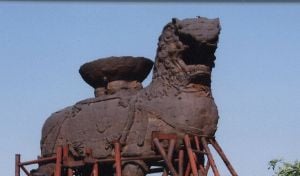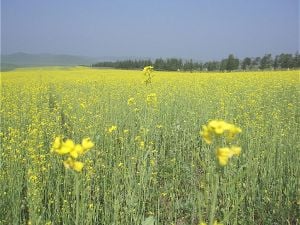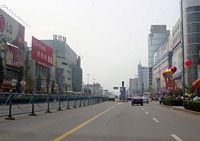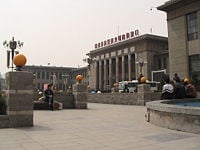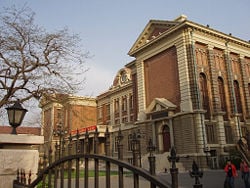Hebei
| 河北省 Héběi Shěng | |
| Abbreviations: 冀 (Pinyin: Jì) | |
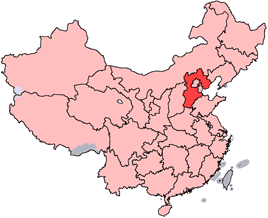
| |
| Origin of name | 河 hé—"(Yellow) River" 北 běi—"north" "north of the Yellow River" |
| Administration type | Province |
| Capital (and largest city) |
Shijiazhuang |
| CPC Ctte Secretary | Zhang Yunchuan (张云川) |
| Governor | Zhang Qingwei (张庆伟) |
| Area | 187700 km² (12th) |
| Population (2010) - Density |
71,854,202 (6th) 372/km² (11th) |
| GDP (2011) - per capita |
CNY 2.40 trillion US$ 379 billion[1] (6th) CNY 28,668 US$ 4,235 (12th) |
| HDI (2008) | 0.810 (high) (10th) |
| Major nationalities | Han: 96% Manchu: 3% Hui: 0.8% Mongol: 0.3% |
| Prefecture-level | 11 divisions |
| County-level | 172 divisions |
| Township-level† | 2207 divisions |
| ISO 3166-2 | CN-13 |
| Official website www.hebei.gov.cn (Simplified Chinese) english.hebei.gov.cn (English) | |
Hebei (Chinese: 河北; pinyin: Hébĕi; Wade-Giles: Ho-pei; Postal map spelling: Hopeh) is a province of the People's Republic of China located in the northeast part of the country.
It borders Liaoning to the northeast, Inner Mongolia to the north, Shanxi to the west, Henan to the south, and Shandong to the southeast. It also completely surrounds Beijing and Tianjin municipalities (which border one another), and a small part of the province (an exclave disjointed from the rest of Hebei's territory) is wedged between the two municipalities.
The name Hebei means "north of the (Yellow) River." Its one-character abbreviation is "冀" (pinyin: jì), named after Ji Province (冀州 Jì Zhōu), a Han Dynasty province (zhou) that included part of what is now southern Hebei. Zhili (Traditional Chinese: 直隸; Simplified Chinese: 直隶; Hanyu Pinyin: Zhílì; Wade-Giles: Chih-li), which means "directly Ruled (by the Imperial Court)," was the name of Hebei before 1928. In addition to these historical names, another common alternate name for Hebei is Yānzhào (燕赵), after the state of Yan and state of Zhao that existed here during the Warring States Period of Chinese history. Hebei's importance lies in its geographical location near Beijing, its fertile plains, abundant natural resources, and historical sites.
History
Hebei's historic importance dates back to the earliest periods of the history of mankind. The plains of Hebei were the home of Peking man, a group of Homo erectus that lived in the area around 200,000 to 700,000 years ago. Neolithic findings at the prehistoric Beifudi site date back to 7000 and 8000 B.C.E. [2]
During the Spring and Autumn Period (722 B.C.E. - 476 B.C.E.), Hebei was under the rule of the states of Yan (燕) in the north and Jin (晉) in the south. Also within this period, a nomadic people known as Dí (狄) invaded the plains of northern China and established Zhongshan (中山) in central Hebei. During the Warring States Period, (403 B.C.E. - 221 B.C.E.), Jin was partitioned, and much of its territory within Hebei went to Zhao (赵).
The territory passed through the hands of the Qin Dynasty (which unified China in 221 B.C.E.), and the Han Dynasty (206 B.C.E. - 220 C.E.), who ruled the area under two provinces (zhou), Youzhou Province (幽州) in the north and Jizhou Province (冀州) in the south. At the end of the Han Dynasty, most of Hebei came under the control of warlords Gongsun Zan in the north and Yuan Shao further south. Yuan Shao emerged victorious among the two, but he was soon defeated by rival Cao Cao, who was based further south, in modern-day Henan) during the Battle of Guandu in 200. After this battle, Hebei came under the rule of the Kingdom of Wei (one of the Three Kingdoms), which was established by the descendants of Cao Cao.
After the invasions of northern nomadic peoples at the end of the Western Jin Dynasty, the chaos of the Sixteen Kingdoms and the Northern and Southern Dynasties ensued. Hebei, firmly in North China and right at the northern frontier, changed hands many times, being controlled at various points in history by the Later Zhao, Former Yan, Former Qin, and Later Yan. The Northern Wei reunified northern China in 440, but split in half in 534, with Hebei coming under the control of the eastern half, which was originally known as the Eastern Wei. Later on, Hebei was controlled by the Northern Qi), which had its capital at Ye (鄴), near modern Linzhang in Hebei, and then the Sui Dynasty, who took control after they unified China in 589.
During the Tang Dynasty (618-907) the area was formally designated as "Hebei" (north of the Yellow River) for the first time. During the earlier part of the Five Dynasties and Ten Kingdoms Period, Hebei was fragmented among several regimes, though it was eventually unified by Li Cunxu, who established the Later Tang Dynasty (923-936). The next dynasty, the Later Jin Dynasty under Shi Jingtang, posthumously known as Emperor Gaozu of Later Jin, ceded much of modern-day northern Hebei to the Khitan Liao Dynasty in the north. This territory, which was known as the Sixteen Prefectures of Yanyun, became a major weakness in China's defense against the Khitans for the next century, since it lay within the Great Wall.
During the Northern Song Dynasty (960-1127), the sixteen ceded prefectures continued to be an area of hot contention between Song China and the Liao Dynasty. The Southern Song Dynasty that ruled subsequently abandoned all of North China, including Hebei, to the Jurchen Jin Dynasty (1115-1234) in 1127.
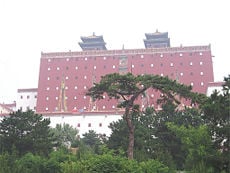
The Mongol Yuan Dynasty divided China into provinces but did not establish Hebei as a province. The Ming Dynasty ruled Hebei as "Beizhili" (北直隸, pinyin: Běizhílì), meaning "Northern Directly Ruled," because the area contained and was directly ruled by the imperial capital, Beijing. The "Northern" designation was used because there was a southern counterpart covering present-day Jiangsu and Anhui. When the Manchu Qing Dynasty came to power in 1644, they abolished the southern counterpart, and Hebei became known as "Zhili," or simply "Directly Ruled." During the Qing Dynasty, the northern borders of Zhili extended deep into what is now Inner Mongolia, and overlapped in jurisdiction with the leagues of Inner Mongolia.
After the Qing Dynasty collapsed in 1912, it was replaced by the Republic of China, founded by Sun Yat Sen. Within a few years, China descended into civil war, with regional warlords vying for power. Since Zhili was so close to Peking (Beijing), the capital, it was the site of frequent wars, including the Zhiwan War, the First Zhifeng War and the Second Zhifeng War. With the success of the Northern Expedition, a successful campaign by the Kuomintang to end the rule of the warlords, the capital was moved from Peking (Beijing) to Nanking (Nanjing). As a result, the name of Zhili was changed to Hebei to reflect that fact that it had a standard provincial administration, and that the capital had been relocated elsewhere.
After the Chinese civil war (1945-1949) and the subsequent founding of the People's Republic of China, the province saw several changes. The region around Chengde, previously part of Rehe Province (historically part of Manchuria), and the region around Zhangjiakou, previously part of Chahar Province (historically part of Inner Mongolia), were both merged into Hebei, extending its borders northwards beyond the Great Wall. The capital was also moved from Baoding to the upstart city of Shijiazhuang, and for a short period to Tianjin.
On July 28, 1976, Tangshan was struck by a powerful earthquake, {the Tangshan earthquake), which was the deadliest earthquake in the twentieth century and resulted in over 240,000 killed. A series of smaller earthquakes struck the city in the following decade.
In 2005, Chinese archaeologists unearthed what is being called the Chinese equivalent of Italy's Pompeii. The find in question, located near Liumengchun Village (柳孟春村) in Cang County in east-central Hebei, is a buried settlement which was destroyed nearly 700 years ago by a major earthquake. Another possible explanation may be the four successive floods which hit the area around the time when the settlement met its sudden end. Although no human remains have been found, copper coins, vases, plates and other items indicate that the settlement appears to have been a booming commercial center during the Song Dynasty.
Geography
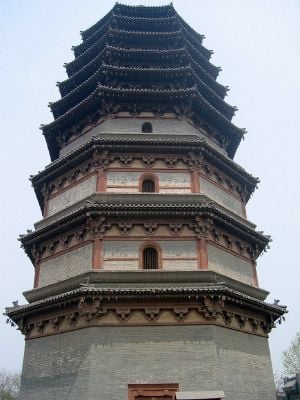
Most of central and southern Hebei lies within the North China Plain. The Taihang Mountains (Taihang Shan) border the province to the west, while the Yan Mountains (Yan Shan) run through the north, creating a geographic border with the grasslands of Inner Mongolia. The Great Wall of China also cuts through northern Hebei from east to west, briefly entering the border of Beijing municipality, and terminating at the seacoast of Shanhaiguan in northeastern Hebei. The highest peak in the province is Mount Xiaowutai in northwestern Hebei, with an altitude of 2,882 m.
The Haihe watershed covers most of the province's central and southern parts, and the Luanhe watershed covers the northeast. Not counting the numerous reservoirs to be found in Hebei's hills and mountains, the largest lake in Hebei is Baiyangdian Lake, located mostly in Anxin County.
Hebei has a continental monsoon climate, with temperatures of -16 to -3 °C in January and 20 to 27 °C in July, and with annual precipitation of 400 to 800 mm, occurring mostly in summer.
Major cities:
- Shijiazhuang
- Baoding
- Tangshan
- Qinhuangdao
- Handan
- Zhangjiakou
Major rivers and lakes:
- Haihe River
- Luanhe River
- Chaobai River
- Yongding River
- Ziya River
- Yansai Lake
- Baiyangdian Lake
Administrative divisions
Hebei is made up of 11 prefecture-level divisions, all of which are designated as prefecture-level cities:
- Shijiazhuang (石家庄市 : Shíjiāzhuāng Shì)
- Tangshan (唐山市 : Tángshān Shì)
- Qinhuangdao (秦皇岛市 : Qínhuángdǎo Shì)
- Handan (邯郸市 : Hándān Shì)
- Xingtai (邢台市 : Xíngtái Shì)
- Baoding (保定市 : Bǎodìng Shì)
- Zhangjiakou (张家口市 : Zhāngjiākǒu Shì)
- Chengde (承德市 : Chéngdé Shì)
- Cangzhou (沧州市 : Cāngzhōu Shì)
- Langfang (廊坊市 : Lángfáng Shì)
- Hengshui (衡水市 : Héngshuǐ Shì)
These prefecture-level cities are subdivided into 172 county-level divisions (22 county-level cities, 108 counties, 6 autonomous counties and 36 districts). Those are, in turn, divided into 2,207 township-level divisions (1 district public office, 937 towns, 979 townships, 55 ethnic townships, and 235 subdistricts).
For a complete list of the county-level divisions of Hebei, see List of administrative divisions of Hebei.
Economy
Hebei has a long history as an agricultural province, and some of its main products are cereal crops such as wheat, maize, millet, and sorghum. In addition to this, cash crops like cotton, tobacco, peanuts, soy beans and sesame are also produced.
Hebei's industrial sector has grown tremendously since the 1950s, and some of its most prominent industries include textiles, coal, steel, iron, chemical production, petroleum, ceramics and food production.
Coal, iron, and petroleum, are specifically very important to Hebei's economy. Kailuan, which is one of China's first modern coal mines (having been opened over 100 years ago), to this day remains a major source of coal for the country, with an annual production of over 20 million metric tons. As well as coal, Hebei is significant for its petroleum resources, most of which are extracted from the North China Oilfield, which is located in the province. There are also major iron mines at Handan and Qian'an.
In 2004, Hebei's GDP was 883.69 billion yuan (US$109.6 billion), an increase of 12.9 percent over the previous year and ranked 6th in the PRC. GDP per capita reached 13,017 Renminbi. Disposable income per capita in urban areas was 7951 RMB, while rural pure income per capita was 3171 RMB. The primary, secondary, and tertiary sectors of industry contributed 137.04 billion, 470.34 billion, and 276.32 billion RMB respectively. The registered unemployment rate was 4 percent. [1]
Demographics
The population is mostly Han Chinese with minorities of Mongol, Manchu, and Hui Chinese.
| Ethnic groups in Hebei, 2000 census | ||
|---|---|---|
| Nationality | Population | Percentage |
| Han Chinese | 63,781,603 | 95.65 percent |
| Manchu | 2,118,711 | 3.18 percent |
| Hui | 542,639 | 0.18 percent |
| Mongol | 169,887 | 0.26 percent |
| Zhuang | 20,832 | 0.031 percent |
Excludes members of the People's Liberation Army in active service.
[3]
Education
According to statistics taken at the end of 2000, there were 47 institutions of higher education in Hebei, with 244,000 students enrolled. Along with these, there were 4,910 secondary schools and 36,465 primary schools. The enrollment rate of primary-school-age pupils was 98.73 percent.
The province has been successful in building a relatively complete educational system involving fundamental education, vocational and technical education, general higher education, and higher learning courses for adults. As a result, the population of Hebei is becoming increasingly educated, and the rate of illiteracy throughout the province has steadily declined in the past few years.
Colleges and universities
Under the national Ministry of Education:
- North China Electric Power University (华北电力大学)
Under other national agencies:
- Central Institute for Correctional Police (中央司法警官学院)
- Chinese People's Armed Police Force Academy (中国人民武装警察部队学院)
- North China Institute of Science and Technology (华北科技学院)
Under the provincial government:
- Chengde Medical College (承德医学院)
- Handan College (邯郸学院)
- Hebei Agricultural University (河北农业大学)
- Hebei Engineering University (河北工程大学)
- Hebei Institute of Architecture and Civil Engineering (河北建筑工程学院)
- Hebei Medical University (河北医科大学)
- Hebei Normal University (河北师范大学)
- Hebei Normal University of Science and Technology (河北科技师范学院)
- Hebei North University (河北北方学院)
- Hebei Physical Educational Institute (河北体育学院)
- Hebei Polytechnic University (河北理工大学)
- Hebei University (河北大学)
- Hebei University of Economics and Business (河北经贸大学)
- Hebei University of Technology (河北工业大学)
- Hebei University of Science and Technology (河北科技大学)
- Hengshui University (衡水学院)
- Langfang Teacher's College (廊坊师范学院)
- North China Coal Medical College (华北煤炭医学院)
- Shijiazhuang College (石家庄学院)
- Shijiazhuang Railway Institute (石家庄铁道学院)
- Shijiazhuang University of Economics (石家庄经济学院)
- Tangshan College (唐山学院)
- Tangshan Teacher's College (唐山师范学院)
- Xingtai University (邢台学院)
- Yanshan University (燕山大学)
Poverty
At the end of 2000, there were over 2.43 million people in the rural areas of Hebei who still needed further support from their local government. As a result, China has created a poverty alleviation and development program, which is to be instituted under the guidance of the provincial government, based on programs submitted by township and county level governments. The general goal of this initiative in the next ten years is to help relieve individuals in poverty-stricken areas, helping them to lead a well-fed and warmly clothed life. In addition, the goal is to further consolidate the achievements made in areas where clothing and food problems have been basically solved, in order to attain the final goal of achieving a stable and comfortable life for the citizens of the province.
Culture
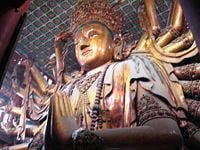
Dialects of Mandarin are spoken throughout most of the province, and most Mandarin dialects in Hebei are in turn classified as part of the Ji Lu Mandarin subdivision. Regions along the western border with Shanxi however, have dialects that are distinct enough for linguists to consider them as part of Jin, another subdivision of Chinese, rather than Mandarin. In general, the dialects of Hebei are quite similar to and readily intelligible with the Beijing dialect, which forms the basis for Standard Mandarin, the official language of the nation. However, there are also some distinct differences, such as differences in the pronunciation of certain words that derive from entering tone syllables (syllables ending on a plosive) in Middle Chinese.
Traditional forms of Chinese opera in Hebei include Pingju, Hebei Bangzi, and Cangzhou Kuaiban Dagu. Pingju is especially popular: it tends to be colloquial in language and hence easy to understand for audiences. Originating from northeastern Hebei, Pingju has been influenced by other forms of Chinese opera like Beijing opera. Traditionally Pingju makes use of just a xiaosheng (young male lead), a xiaodan (young female lead), and a xiaohualian (young comic character), though it has since diversified with the use of other roles as well.
Quyang County, in central Hebei, is famous for its Dingzhou porcelain, which includes various vessels such as bowls, plates, vases, and cups, as well as figurines. Dingzhou porcelain is usually creamy white, though it is also made in other colors.
Hebei cuisine is typically based on wheat, mutton and beans with specialties including salted pickled duck eggs, sea crabs, and braised chicken.
Tourism

Hebei receives quite a lot of attention from tourists, largely due to its proximity to Beijing and also because of the presence of the Great Wall within its provincial territory. The east end of the Ming Great Wall is located on the coast of Hebei, at Shanhaiguan (Shanhai Pass), near Qinhuangdao. Informally it is known as the "First Pass of The World" (天下第一關), and it is the place where Ming general Wu Sangui opened the gates to Manchu forces in 1644, beginning nearly 300 years of Manchu rule. The pass also marks the entrance to Manchuria, so for centuries Manchuria was considered "outside the Pass" or "east of the Pass." Beidaihe, located near Shanhaiguan, is a popular beach resort well known as a former meeting place for top governmental officials.
The Chengde Mountain Resort and its outlying temples were named a UNESCO World Heritage Site. Also known as the Rehe Palace, this was the summer resort of the Manchu Qing Dynasty emperors. The Chengde Resort was built between 1703 and 1792, and consists of a palace complex, a large park area consisting of lakes, pavilions, causeways, bridges, etc., and a number of Tibetan Buddhist and Han Chinese temples in the surrounding area.
There are several Qing Dynasty imperial tombs at Zunhua (East Qing Tombs) and Yixian (West Qing Tombs). The East Qing Tombs is the resting place of 161 Qing emperors, empresses, and other members of the Qing imperial family, while the West Qing Tombs has 76. These are also part of a World Heritage Site.
The Zhaozhou Anji Bridge, built by Li Chun during the Sui Dynasty, is the oldest stone arch bridge in China, and one of the most significant examples of pre-modern Chinese civil engineering.
Baoding, the old provincial capital, contains the historical Zhili Governor's Residence.
Xibaipo, a village about 90 km from Shijiazhuang, was the location of the Central Committee of the Communist Party of China and the headquarters of the People's Liberation Army during the decisive stages of the Chinese Civil War between May 26, 1948 and March 23, 1949, at which point they were moved to Beijing. Today, the area houses a memorial site.
Transportation
Since Hebei surrounds Beijing, many important railway lines radiating out of Beijing pass through the provincial territory. The Jingguang Railway (which connects Beijing to Guangzhou) is one of the most important, since it passes through major cities like Baoding, Shijiazhuang, Xingtai and Handan on its way through Hebei from north to south. Other important railways include the Jingjiu Railway (which connects Beijing to Kowloon), the Jinghu Railway (which connects Beijing to Shanghai), the Jingha Railway (which connects Beijing to Harbin), and the Jingbao Railway, (which connects Beijing to Baotao).
The recent expressway boom in China has not left Hebei behind. There are expressways to every prefecture-level city of Hebei except Chengde, totaling approximately 2,000 kilometers. The entire length of highways within Hebei is around 40,000 kilometers.
In addition to rail and highways, there are also a number of ports in Hebei along the Bohai Sea, including Qinhuangdao (the second busiest in China with a capacity of over 100 million tons), Huanghua, and Jingtang. Shijiazhuang's Zhengding Airport is the province's center of air transportation, with both domestic and international flights.
Notes
- ↑ Hebei saw 12 percent GDP growth in 2010 The People's Government of Hebei Province (January 28, 2011). Retrieved June 28, 2012.
- ↑ "New Archaeological Discoveries and Researches in 2004"—The Fourth Archaeology Forum of CASS. Institute of Archaeology, Chinese Academy of Social Sciences.
- ↑ Source: Department of Population, Social, Science and Technology Statistics of the National Bureau of Statistics of China (国家统计局人口和社会科技统计司) and Department of Economic Development of the State Ethnic Affairs Commission of China (国家民族事务委员会经济发展司), eds. Tabulation on Nationalities of 2000 Population Census of China (《2000年人口普查中国民族人口资料》). 2 vols. Beijing: Nationalities Publishing House (民族出版社), 2003.
ReferencesISBN links support NWE through referral fees
- Anson, Ofra, and Sun Shifang. 2005. Health care in rural China lessons from HeBei Province. Aldershot, Hants, England: Ashgate. ISBN 9780754642718
- Li, Lillian M. 2007. Fighting famine in North China state, market, and environmental decline, 1690s-1990s. Stanford, CA: Stanford University Press. ISBN 9780804753043
- Myers, Ramon Hawley. 1970. The Chinese peasant economy; agricultural development in Hopei and Shantung, 1890-1949. Harvard East Asian series, 47. Cambridge: Harvard University Press. ISBN 9780674124516
External links
All links retrieved June 25, 2024.
Prefecture-level divisions of Hebei
| ||
| List of Hebei County-level divisions |
| Province-level divisions administered by the People's Republic of China (PRC) | |
|---|---|
| Provinces | Anhui · Fujian · Gansu · Guangdong · Guizhou · Hainan · Hebei · Heilongjiang · Henan · Hubei · Hunan · Jiangsu · Jiangxi · Jilin · Liaoning · Qinghai · Shaanxi · Shandong · Shanxi · Sichuan · Taiwan · Yunnan · Zhejiang |
| Autonomous regions | Guangxi · Inner Mongolia · Ningxia · Tibet (Xizang) · Xinjiang |
| Municipalities | Beijing · Chongqing · Shanghai · Tianjin |
| Special administrative regions | Hong Kong · Macau |
Credits
New World Encyclopedia writers and editors rewrote and completed the Wikipedia article in accordance with New World Encyclopedia standards. This article abides by terms of the Creative Commons CC-by-sa 3.0 License (CC-by-sa), which may be used and disseminated with proper attribution. Credit is due under the terms of this license that can reference both the New World Encyclopedia contributors and the selfless volunteer contributors of the Wikimedia Foundation. To cite this article click here for a list of acceptable citing formats.The history of earlier contributions by wikipedians is accessible to researchers here:
The history of this article since it was imported to New World Encyclopedia:
Note: Some restrictions may apply to use of individual images which are separately licensed.
